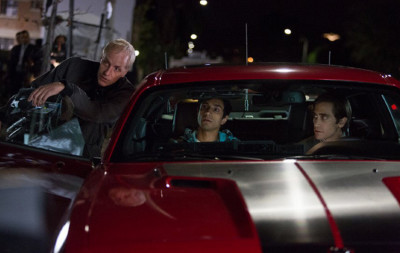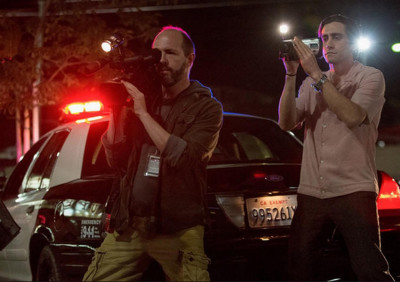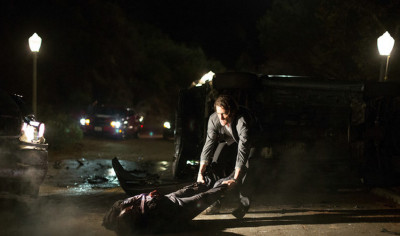When it came to choosing a cinematographer to create an indelible and evocative visual style for “Nightcrawler”, writer and first-time director Dan Gilroy went with one of the best, Robert Elswit. Known to Gilroy for his work on brother Tony Gilroy’s films (not to mention being godfather to “Nightcrawler” star Jake Gyllenhaal), Elswit proved invaluable to creating the slick, polished, saturated, often surreal look of the film.
“When I sat down with Robert, he read the script. He found it to be very subversive – that was the word he used – which he loved.” Elswit, who lives in the Venice area, has a keen observational eye, as does fellow Angeleno, Gilroy. “[W]e started talking about Los Angeles, and how you look out the window and it’s all trees and mountains, and how often in Los Angeles films, you see cement and freeways and downtown; how we wanted to capture more the wild aspect of L.A. and more of the natural beauty, like going up on top of a hill and looking down and seeing far, or looking up at a mountain and seeing Mt. Wilson and those shots of antennas. We wanted to capture a wild, untamed energy in the sense of a character like Lou [Bloom], almost like a coyote roaming through this wilderness, this landscape that had a physical beauty to it.”
To achieve this untamed look of the nighttime underbelly of Los Angeles, “We shot a lot of really wide angle lenses. It’s such a cool view out there and we wanted to try and capture as much of that as possible and to see as far as you can see. It’s that sort of deep focus and not shallow focus.”
Adding a unique element to the visual palette is the eye of Jake Gyllenhaal himself. As a “nightcrawler”, Gyllenhaal’s character Lou Bloom has a camera at the ready and to achieve authenticity, Gyllenhaal was indeed shooting some of the footage we now see onscreen. According to Gilroy, “[Gyllenhaal] practiced. He took the camera home a week before and he practiced with it. He did know how to use the camera. He carried it around all the time.” Notable are the images captured during a climactic car chase. “There were many times that it was Jake’s shot or what Riz [Ahmed] shot that we used. . . . Sometimes that was the only footage we had because we were moving so fast. It was like, ‘Wait! We didn’t get that?’ and we wound up looking in their cameras and finding it.”
As Jake Gyllenhaal notes, “Nightcrawler” is shot “deep [San Fernando] Valley. Dan’s whole intention with this movie was to show Los Angeles as not the Los Angeles that we know, not the downtown we’ve seen in films. We see a little bit of Santa Monica, but even the Santa Monica we see is lit like this crazy vibrance. There’s that deep valley look.” Reflecting, Gyllenhaal expounds on his personal observations about Los Angeles. “We’re all isolated. That’s the thing about L.A. that I started to see making movies here. No matter what your socio-economic background, you’re isolated. It doesn’t matter. It’s just the way we transport around here. Whether you take a bus, a car, whatever it is, it’s not like a lot of other cities. Dan kind of burst that open and we were in areas that I had never [seen] like way deep Valley. The last shot is not deep Valley, but Glendale, which is a strip. . .It’s so L.A. It has the essence of Los Angeles.”
Second Unit Director Mike Smith, whom Gilroy credits with having “brought an incredible team of stunt drivers and riggers and car manufacturers to the table” worked extensively with Gilroy, Elswit and Tony Gilroy on a mind-blowing nighttime car chase “in crafting the look and what we wanted, to make it compressed and compact and to really focus in on the quality of what you’re watching rather than drawing it out for long periods of time.”
What Dan Gilroy himself found interesting is “visually one of the things that came out of this was, when I started to work with Robert and we started to go location scouting with the cameras that Lou’s character uses, the little viewfinder that he looks at, Robert started to go, ‘You know, the viewfinders are interesting. We could start to show the action through the viewfinder rather than showing the action in large scale.’ That became a really important idea, because when we have the shootout at the restaurant, that’s all coming through the viewfinders. If you go back and look at it, everything is in soft focus. It’s really your eye is drawn to this little viewfinder until finally we pull back at the very end. We’re keeping the action close in the chase to the characters. And in the chase, we’re staying in the car as much as possible. So when the car gets hit in the intersection, you see that through the windshield, whereas in a lot of chase movies, or in movies that have a chase, they would jump ahead a hundred yards and do a wide angle and they’d take you out of the action to show the spectacle of it. We wanted to show it from the point of view of what was going on in the car. I thought that made it more visceral and more personal.”

















